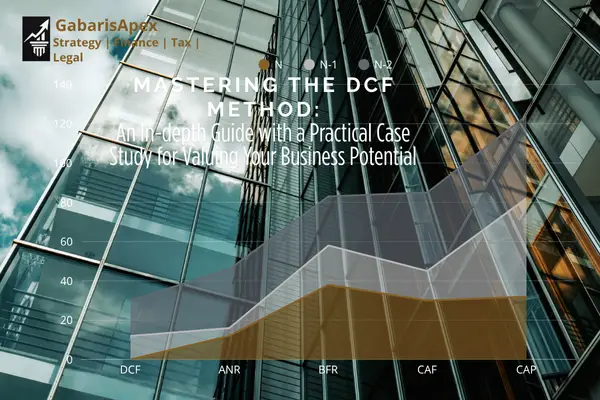Mastering the DCF Method: An In-depth Guide with a Practical Case Study for Valuing Your Business Potential
In the complex world of business valuation, the Discounted Cash Flow (DCF) method stands out as a cornerstone. It's a forward-looking approach that determines a company's intrinsic value based on its ability to generate future cash flows. Unlike asset-based methods, DCF focuses on potential, making it especially relevant for growth-oriented companies or those with significant intangible assets. Understanding DCF is essential for investors, financial analysts, and business owners looking to assess true long-term value.
Understanding the Core Components of DCF
The DCF method essentially boils down to three main components:
1. Free Cash Flow (FCF)
Free Cash Flow (FCF) represents the cash a company generates after accounting for cash outflows to support its operations and maintain its capital assets. It's the cash available to all capital providers (both debt and equity holders). FCF is a critical measure because it shows the true cash generated by the business, independent of non-cash expenses like depreciation or amortization.
FCF = EBIT x (1 - Tax Rate) + Depreciation & Amortization - Capital Expenditures - Change in Working Capital
2. Weighted Average Cost of Capital (WACC) - The Discount Rate
The Weighted Average Cost of Capital (WACC) is the discount rate used to bring future cash flows back to their present value. It represents the average rate of return a company expects to pay to all its different investors (both bondholders and shareholders). WACC takes into account the cost of equity and the after-tax cost of debt, weighted by their respective proportions in the company’s capital structure.
WACC = (E / V) x Re + (D / V) x Rd x (1 - T)
- E: Market value of the firm’s equity
- D: Market value of the firm’s debt
- V: Total market value of firm's financing (E + D)
- Re: Cost of equity
- Rd: Cost of debt
- T: Corporate tax rate
3. Terminal Value (TV)
Since it’s impractical to forecast cash flows indefinitely, the Terminal Value (TV) captures the value of a company beyond the explicit forecast period (typically 5-10 years). It assumes the company will grow at a constant rate indefinitely (perpetual growth model) or will be liquidated at a certain point. The most common method uses the Gordon Growth Model:
TV = (FCF_last forecast year x (1 + g)) / (WACC - g)
- g: Sustainable growth rate in perpetuity
Practical Case Study: Valuing "Example -1" using DCF
Let's apply the DCF method to our hypothetical company, Example -1.
Example -1 Data:
- Forecasted Free Cash Flows (FCF):
- Year 1: 1,000 thousand euros
- Year 2: 1,200 thousand euros
- Year 3: 1,400 thousand euros
- Weighted Average Cost of Capital (WACC): 8%
- Perpetual Growth Rate (g) after Year 3: 2%
DCF Calculation Steps:
-
Discount FCFs for the explicit forecast period:
- FCF Year 1 (PV): 1000 / (1+0.08)^1 = 925.93 thousand euros
- FCF Year 2 (PV): 1200 / (1+0.08)^2 = 1028.80 thousand euros
- FCF Year 3 (PV): 1400 / (1+0.08)^3 = 1111.39 thousand euros
-
Calculate Terminal Value (TV) at the end of Year 3:
TV = (1400 x (1 + 0.02)) / (0.08 - 0.02) = 1428 / 0.06 = 23800 thousand euros
-
Discount the Terminal Value back to present:
PV(TV) = 23800 / (1+0.08)^3 = 18892.42 thousand euros
-
Sum all Present Values for Total DCF Valuation:
DCF Value = 925.93 + 1028.80 + 1111.39 + 18892.42 = **21,958.54 thousand euros**
Advantages and Limitations of the DCF Method
Advantages:
- Intrinsic Value Focus: Provides a robust estimate of a company's intrinsic value based on its fundamental ability to generate cash.
- Future-Oriented: Reflects the company's future potential and growth prospects, making it suitable for high-growth businesses.
- Flexibility: Allows for detailed modeling of various scenarios (e.g., different growth rates, cost structures).
- Widely Accepted: A preferred method among financial professionals and academics.
Limitations:
- Sensitivity to Assumptions: Highly dependent on inputs like FCF forecasts, WACC, and the terminal growth rate. Small changes can lead to large swings in valuation.
- Difficulty in Forecasting: Predicting future cash flows accurately, especially for young or volatile companies, is challenging.
- Terminal Value Dominance: The Terminal Value often accounts for a significant portion (50-80%+) of the total DCF value, making it a critical and often subjective assumption.
- Doesn't Account for Market Sentiment: Focuses on intrinsic value, not necessarily how the market currently perceives the company.
Conclusion
The DCF method remains an indispensable tool in business valuation, offering a comprehensive look at a company's future earning potential. While it requires careful forecasting and assumption-setting, its focus on intrinsic value makes it a powerful complement to other valuation approaches like the Adjusted Net Book Value or comparable company analysis. Mastering DCF allows for a deeper understanding of what truly drives a business's worth and provides a solid foundation for investment and strategic decisions.

إرسال تعليق